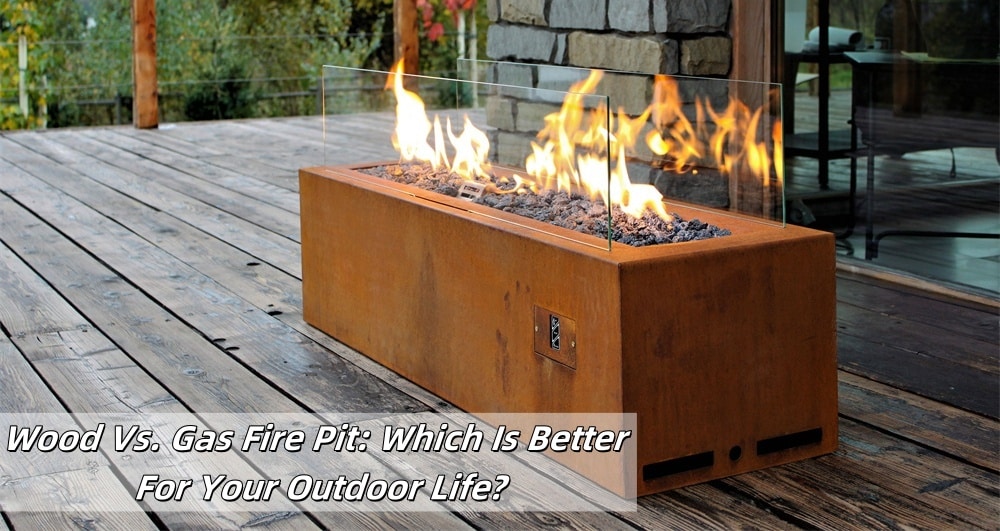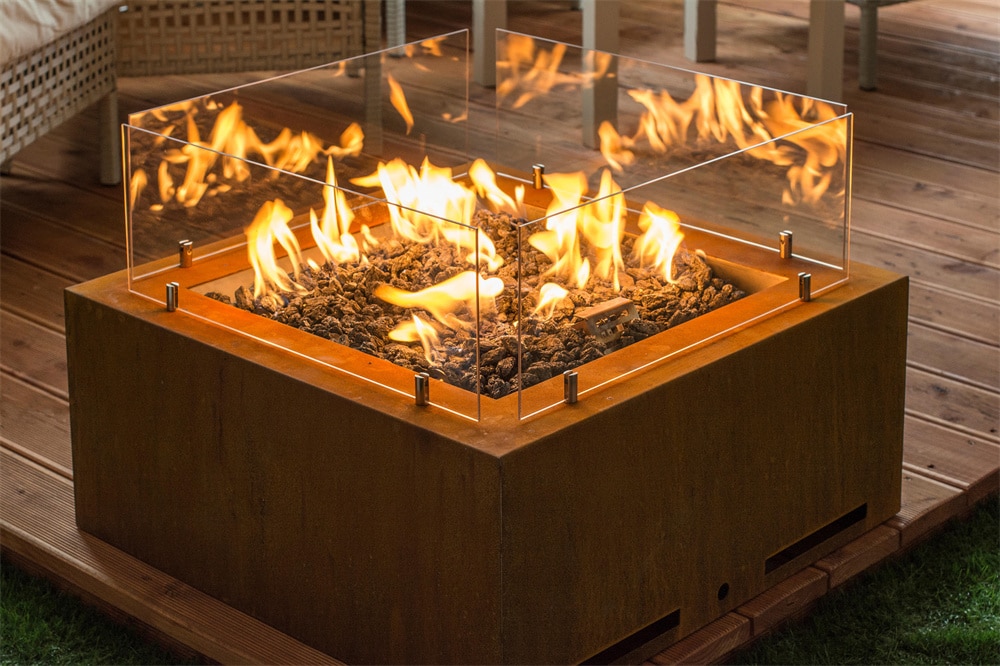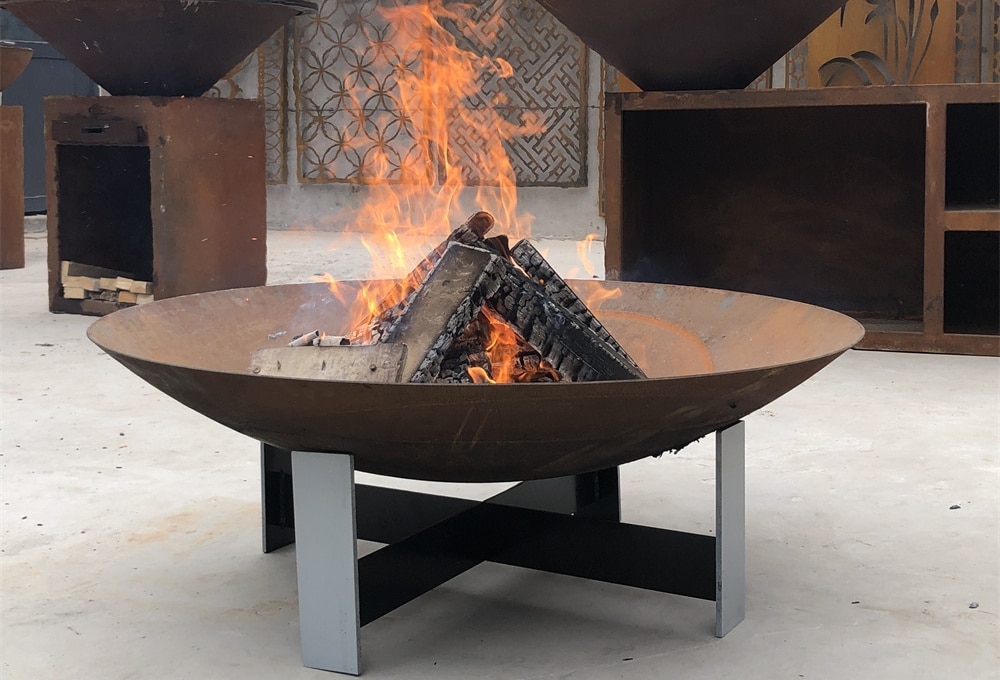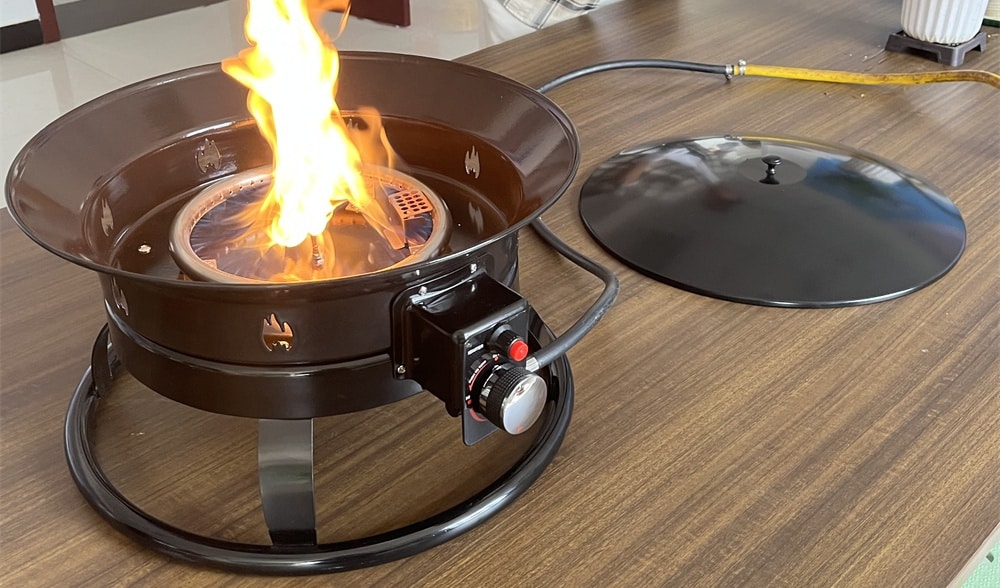
Table of Contents
When night falls, people gather in the backyard or campground to share stories and bake food around the warm firelight. However, when planning such a gathering space, many people will face an important choice: choose a traditional wood-burning fire pit or a modern & convenient gas fire pit?
This question seems simple, but it actually involves considerations in many dimensions. From user experience to maintenance costs, from safety to environmental protection, each aspect has its unique characteristics and advantages. In order to choose the right fire pit, we need to have a deep understanding of the characteristics, advantages and disadvantages of wood-burning fire pits and gas fire pits.
What Is a Wood-Burning Fire Pit?
A wood-burning fire pit is an outdoor heating and entertainment facility that uses wood as fuel, usually constructed of metal, stone or brick. It can be a portable metal container or a permanent stone or brick structure installed in a backyard, patio or dedicated outdoor space.
Structurally, a wood-burning fire pit generally consists of a fire pit body and supporting legs or a base. Some designs also include grill attachments for outdoor cooking. In terms of materials, common ones include stainless steel, cast iron, weathering steel, and natural stone, each with different durability and aesthetic effects.
What Is a Gas Fire Pit?
A gas fire pit is an outdoor heating and decorative device that uses natural gas or liquefied petroleum gas (usually propane) as fuel. It is often used in places such as courtyards, terraces, gardens, and hotel outdoor spaces. It is usually made of heat-resistant steel, equipped with a burner, ignition system, and gas connection pipes. It can be easily ignited by a knob or button, quickly producing a stable and adjustable flame.
In addition, gas fire pits can also be paired with decorative materials such as volcanic stone to enhance the aesthetics and create a high-end and elegant visual effect.

Wood-Burning Fire Pits Vs. Gas Fire Pits, How To Choose?
1. Fuel Cost
Wood-burning fire pits use wood as fuel, and the price of wood is relatively stable and widely available. You can buy commercially dried wood, collect dead branches and leaves from your yard, or even buy scrap wood from a local lumber dealer. Generally speaking, a bundle of high-quality dry wood can burn for 2-3 hours and costs about 15-25 yuan, which makes wood-burning fire pits economical in long-term use.
In contrast, gas fire pits use propane or natural gas as fuel. The price of a propane tank is relatively fixed, and a standard 20-pound propane tank can be used for about 10-15 hours at a cost of about 80-120 yuan. Although the single purchase cost is higher, gas burns more efficiently and has a more stable heat output. If your home is already connected to the natural gas pipeline, the operating cost of a gas fire pit will be significantly reduced, and the fuel cost per hour may be only a few yuan.
2. Supply Convenience
From the perspective of supply convenience, wood-burning fire pits need to prepare and store wood in advance, which requires a certain amount of storage space, and the wood needs to be kept dry to ensure good combustion. Keeping wood dry can be a challenge, especially in rainy seasons or humid environments. Gas fire pits only need to ensure sufficient gas supply, propane tanks can be replaced at any time, and natural gas pipelines provide a continuous and stable fuel supply, which is more convenient to use.
2. Convenience Of Operation
The ignition process of a wood-burning fire pit is relatively complicated. It is necessary to prepare ignition materials such as newspapers, hay or ignition blocks, and then gradually add thin wood strips and coarse wood. The entire ignition process may take 10-20 minutes and requires certain skills and patience. Once the flame is established, maintaining the fire requires regular addition of wood, which requires continuous attention and operation by the user. For users who are not familiar with fire-making skills, it may take multiple attempts to successfully ignite.
Gas fire pits have obvious advantages in terms of operational convenience. Modern gas fire pits are usually equipped with electronic ignition systems, which can be ignited instantly with just a tap of a button or a turn of a switch. The size of the flame can be precisely controlled by adjusting the valve, and it can be easily achieved from a small flame to a raging fire. When it is not needed, just turn off the gas valve and the flame will go out immediately. The whole process is safe and fast.

3. Cleaning
In terms of maintenance operations, the ashes need to be cleaned after the wood-burning fire pit is used to ensure that the combustion is completely extinguished. Gas fire pits are relatively simple to maintain, mainly cleaning the burner and checking the gas connection, without the need to deal with ashes and residues.
4. User Experience
The slight crackling sound of wood burning adds to the enjoyment of the auditory level, and this sound often reminds people of warm family time and good memories of outdoor adventures. For users who pursue the traditional fire pit experience, wood-burning fire pits provide a more authentic feeling.
Although gas fire pits are slightly inferior in creating the original atmosphere, modern design has greatly improved this. High-quality gas fire pits can also produce flame effects. In order to increase the aesthetics, many gas fire pits install transparent glass protection around the flames, which not only ensures safety but also enhances the visual effect. The reflection of the glass makes the flames look more brilliant and charming. In addition, placing beautiful decorative materials such as volcanic stones on the burner can not only improve thermal efficiency, but also create a unique visual effect.
5. Safety Performance
There are some inherent safety risks in the use of wood-burning fire pits. Sparks may fly when wood burns, and these sparks may ignite nearby combustible materials, especially in dry environments. The risk is higher. In response to this problem, many wood-burning fire pits are equipped with spark-proof mesh covers or can choose fire pit designs with lids. These safety devices can effectively block most of the flying sparks and significantly reduce the risk of fire.

Gas fire pits have certain advantages in terms of safety. The exhaust gas produced by the combustion of modern gas fire pits is relatively clean, mainly carbon dioxide and water vapor, which has less impact on the environment and health. However, gas fire pits also have their own specific safety risks, mainly the possibility of gas leakage. Gas leaks may cause explosions or poisoning accidents, so it is necessary to regularly check the gas pipes and connectors to ensure that the system is well sealed. The gas smell should be checked before use. If any abnormality is found, it should be stopped immediately and the system should be checked.
6. Installation
Wood-burning fire pits are relatively simple to install. Most portable wood-burning fire pits do not require professional installation. Just choose a suitable location to use. However, the use of wood-burning fire pits requires consideration of smoke diffusion and safety distance, ensuring that there are no flammable substances around and that there is enough ventilation space.
The installation of gas fire pits is more complicated, especially when using natural gas fire pits. This type of fire pit requires professionals to connect the fire pit to the gas pipe or propane tank. Gas fire pits usually require a flat and stable foundation, and make sure that the gas pipes are not damaged.

Maintenance And Long-Term Use
No matter which type of fire pit you choose, proper maintenance is the key to ensure long-term use and safety. Different types of fire pits require different maintenance methods and precautions.
- Wood Burning Fire Pit
The maintenance of wood-burning fire pits focuses on cleaning and structural protection. Ashes and unburned wood residues should be thoroughly cleaned after each use. Ashes should be handled only after they are completely cooled. Try not to use water directly to extinguish the flame. The sudden temperature difference can easily cause the fire pit to crack. Sand can be used if necessary.
- Gas Fire Pits:
The maintenance of gas fire pits is relatively simple, but it still needs to be carried out regularly. The main maintenance work includes checking the tightness of the gas connection, cleaning the surface of the burner, and checking the function of the ignition system. The gas connection should be checked regularly with soapy water for leaks. If bubbles are found, it should be stopped immediately and professional repairs should be sought.
The cleanliness of the burner is important for the performance of the gas fire pit. Dust and debris may clog the holes of the burner and affect the uniformity of the flame. Clean the burner surface regularly with a soft brush to keep the holes clear. The ignition system also needs to be checked regularly to ensure that the battery is fully charged and the igniter is working properly.
When not in use for a long time, the main gas valve should be turned off and the fire pit should be protected from the weather with a protective cover.
For both types of fire pits, regular professional inspections are recommended. Especially for gas fire pits, an annual professional inspection can ensure the safety and reliability of the system. Professional technicians can find potential problems that are difficult for users to detect and repair them in time.
When choosing an outdoor fire pit, wood-burning fire pits and gas fire pits each have their own unique advantages and limitations. Wood-burning fire pits provide a traditional campfire experience, bringing the original wood burning aroma and crackling sound, creating a strong outdoor atmosphere, while the fuel cost is relatively low. However, it requires more maintenance work, including cleaning ash, storing wood, and may be restricted by fire prevention regulations in some areas.
In contrast, gas fire pits are easy to operate, just flick a switch to ignite, the flame size is easy to control, almost no smoke and ash is produced, and cleaning and maintenance are relatively easy. However, the initial investment cost is high, the propane tank needs to be replaced regularly or the natural gas pipeline needs to be connected, and the natural feeling of the traditional campfire and the unique aroma of burning wood are missing.
Choosing which fire pit is mainly a matter of personal preference. I hope the above content will help you.




